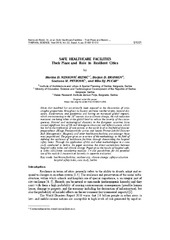Safe healthcare facilities - Their place and role in resilient cities
Апстракт
Given that mankind has occasionally been exposed to the devastation of catastrophic proportions throughout its history (extreme weather events, natural disasters, bioterrorism, and pandemics are having an increased global impact), which are increasing in the 20th century due to climate change, the risk reduction measures are being taken at the global level to reduce the severity of the consequences. Natural and technological disasters in the European countries have caused significant loss of life and damage to structures and infrastructure, which has led to the ratification of conventions at the world level in the field of disaster preparedness (Hyogo Framework for Action and Sendai Framework for Disaster Risk Management). Hospitals and other healthcare facilities are amongst those most jeopardized. The paper gives an overview of the methodology in the field of defining the resilience of healthcare facilities through determining the hospital safety index. Through the application of thi...s and other methodologies in a case study conducted in Serbia, the paper examines the direct correlations between hospital safety index and climate change. Paper gives the results of hospital safety index calculation considering modules 2-4 and possibilities for the potential use of the module 1 (research on hazards) in separate evaluation.
Кључне речи:
healthcare facilities / resilient city / climate change / safety evaluation / hospital safety index / case study / SerbiaИзвор:
Thermal Science, 2018, 22Издавач:
- VINCA Institute of Nuclear Sciences
Финансирање / пројекти:
- Просторни, еколошки, енергетски и друштвени аспекти развоја насеља и климатске промене - међусобни утицаји (RS-MESTD-Technological Development (TD or TR)-36035)
DOI: 10.2298/TSCI170531125N
ISSN: 0354-9836
WoS: 000450540300005
Scopus: 2-s2.0-85057130331
Група
RAUmPlanTY - JOUR AU - Nenković-Riznić, Marina AU - Brankov, Borjan D. AU - Peirović, Snežana M. AU - Pucar, Mila PY - 2018 UR - https://raumplan.iaus.ac.rs/handle/123456789/304 AB - Given that mankind has occasionally been exposed to the devastation of catastrophic proportions throughout its history (extreme weather events, natural disasters, bioterrorism, and pandemics are having an increased global impact), which are increasing in the 20th century due to climate change, the risk reduction measures are being taken at the global level to reduce the severity of the consequences. Natural and technological disasters in the European countries have caused significant loss of life and damage to structures and infrastructure, which has led to the ratification of conventions at the world level in the field of disaster preparedness (Hyogo Framework for Action and Sendai Framework for Disaster Risk Management). Hospitals and other healthcare facilities are amongst those most jeopardized. The paper gives an overview of the methodology in the field of defining the resilience of healthcare facilities through determining the hospital safety index. Through the application of this and other methodologies in a case study conducted in Serbia, the paper examines the direct correlations between hospital safety index and climate change. Paper gives the results of hospital safety index calculation considering modules 2-4 and possibilities for the potential use of the module 1 (research on hazards) in separate evaluation. PB - VINCA Institute of Nuclear Sciences T2 - Thermal Science T1 - Safe healthcare facilities - Their place and role in resilient cities VL - 22 DO - 10.2298/TSCI170531125N ER -
@article{
author = "Nenković-Riznić, Marina and Brankov, Borjan D. and Peirović, Snežana M. and Pucar, Mila",
year = "2018",
abstract = "Given that mankind has occasionally been exposed to the devastation of catastrophic proportions throughout its history (extreme weather events, natural disasters, bioterrorism, and pandemics are having an increased global impact), which are increasing in the 20th century due to climate change, the risk reduction measures are being taken at the global level to reduce the severity of the consequences. Natural and technological disasters in the European countries have caused significant loss of life and damage to structures and infrastructure, which has led to the ratification of conventions at the world level in the field of disaster preparedness (Hyogo Framework for Action and Sendai Framework for Disaster Risk Management). Hospitals and other healthcare facilities are amongst those most jeopardized. The paper gives an overview of the methodology in the field of defining the resilience of healthcare facilities through determining the hospital safety index. Through the application of this and other methodologies in a case study conducted in Serbia, the paper examines the direct correlations between hospital safety index and climate change. Paper gives the results of hospital safety index calculation considering modules 2-4 and possibilities for the potential use of the module 1 (research on hazards) in separate evaluation.",
publisher = "VINCA Institute of Nuclear Sciences",
journal = "Thermal Science",
title = "Safe healthcare facilities - Their place and role in resilient cities",
volume = "22",
doi = "10.2298/TSCI170531125N"
}
Nenković-Riznić, M., Brankov, B. D., Peirović, S. M.,& Pucar, M.. (2018). Safe healthcare facilities - Their place and role in resilient cities. in Thermal Science VINCA Institute of Nuclear Sciences., 22. https://doi.org/10.2298/TSCI170531125N
Nenković-Riznić M, Brankov BD, Peirović SM, Pucar M. Safe healthcare facilities - Their place and role in resilient cities. in Thermal Science. 2018;22. doi:10.2298/TSCI170531125N .
Nenković-Riznić, Marina, Brankov, Borjan D., Peirović, Snežana M., Pucar, Mila, "Safe healthcare facilities - Their place and role in resilient cities" in Thermal Science, 22 (2018), https://doi.org/10.2298/TSCI170531125N . .



